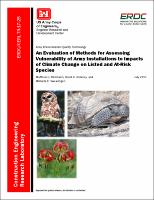Please use this identifier to cite or link to this item:
https://hdl.handle.net/11681/22772Full metadata record
| DC Field | Value | Language |
|---|---|---|
| dc.contributor.author | Hohmann, Matthew G. | - |
| dc.contributor.author | Delaney, David K. | - |
| dc.contributor.author | Swearingen, Michelle E. | - |
| dc.date.accessioned | 2017-07-27T13:59:17Z | - |
| dc.date.available | 2017-07-27T13:59:17Z | - |
| dc.date.issued | 2017-07 | - |
| dc.identifier.uri | http://hdl.handle.net/11681/22772 | - |
| dc.identifier.uri | http://dx.doi.org/10.21079/11681/22772 | - |
| dc.description.abstract | Abstract: Environmental factors have received only limited attention as part of past Base Realignment and Closure (BRAC) decision-making processes, and climate-change impacts have not yet been considered. During BRAC 2005, the Army considered listed and at-risk species as part of its environmental-criterion analysis. These species affect BRAC analyses given that their status can lead to restrictions on training land use, and that such restrictions are likely to increase under future rules addressing climate change. The objectives of this work were to identify prospective approaches for assessing the vulnerability of installations to climate-change impacts on listed and at-risk species, and to evaluate their suitability for informing BRAC-related evaluations. Three recently developed methods for assessing the vulnerability of Army installations to impacts of climate change on listed and at-risk species were evaluated using the SMART (Specific, Measurable, Attainable, Realistic, and Timely) decision analysis framework. Each method was rated against the SMART criteria and an aggregate score was provided. The assessment approach having the maximum aggregate score was recommended as likely suitable for informing future BRAC and restationing evaluations. It characterizes installation and regional climate change vulnerability by integrating multiple factors related to exposure, sensitivity, adaptive capacity, and number of listed and at-risk species. | en_US |
| dc.description.sponsorship | Army Environmental Quality Technology Program (U.S.) | en_US |
| dc.description.sponsorship | United States. Office of the Assistant Secretary of the Army for Acquisition, Logistics, and Technology. | - |
| dc.language.iso | en | en_US |
| dc.publisher | Construction Engineering Research Laboratory (U.S.) | en_US |
| dc.publisher | Engineer Research and Development Center (U.S.) | en_US |
| dc.relation.ispartofseries | ERDC/CERL;TR-17-25 | - |
| dc.subject | Military bases–-United States | en_US |
| dc.subject | Endangered species | en_US |
| dc.subject | Climatic changes | en_US |
| dc.subject | Environmental impact analysis | en_US |
| dc.subject | Environmental management | en_US |
| dc.title | An evaluation of methods for assessing vulnerability of Army installations to impacts of climate change on listed and at-risk species | en_US |
| dc.type | Report | en_US |
| Appears in Collections: | Technical Report | |
Files in This Item:
| File | Description | Size | Format | |
|---|---|---|---|---|
| ERDC-CERL TR-17-25.pdf | 348.68 kB | Adobe PDF |  View/Open |